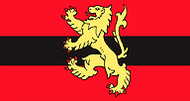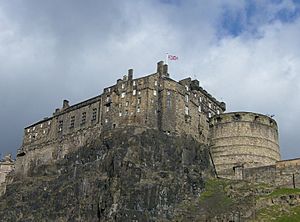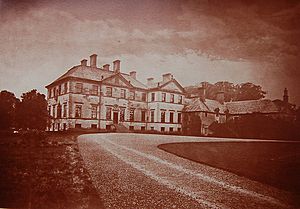Scottish Command facts for kids
Quick facts for kids Scottish Command (from 1972 Army Headquarters Scotland) |
|
|---|---|
 |
|
| Active | 1905–1972 2012–2014 |
| Country | United Kingdom |
| Branch | |
| Type | Command |
| Garrison/HQ | Edinburgh |
Scottish Command or Army Headquarters Scotland (from 1972) is an important part of the British Army. It is a type of military group called a command. This command helps manage and organize army units in Scotland.
Contents
- History of Scottish Command
- Leaders of Scottish Command
- Commander-in-Chief, Scottish Army
- Commander-in-Chief, Scotland (or North Britain)
- Commanding the Troops in the North British District
- Commanding the Troops in the Scottish District
- General Officer Commanding-in-Chief Scottish District
- General Officer Commanding-in-Chief Scottish Command
- General Officer Commanding, Scotland
- Military Secretary and General Officer, Scotland
History of Scottish Command
How Scottish Command Started

In 1793, when Britain went to war with France, the country was split into different military areas. Scotland had its own area, led by a Commander-in-Chief.
Later, in 1876, a plan was made to organize the army into eight large groups called army corps. The 8th Corps was meant to be in Scotland, based in Edinburgh. This plan changed in 1881, and the areas were simply called 'District Commands'.
The Early 1900s
In 1901, new army plans suggested creating six army corps based on different regions. For Scotland, the plan was to form the 6th Corps, with its main office in Edinburgh. Lieutenant General Sir Charles Tucker was put in charge in 1903.
Scottish Command officially started in 1905. Its first home was Edinburgh Castle. However, in 1955, it moved to a new place called Craigiehall.
Scottish Command in World War I
During World War I, the British Army needed many more soldiers. In August 1914, a 'New Army' was created, made up of volunteers. These new soldiers were organized into divisions.
Scottish Command helped form two important divisions:
- The 9th (Scottish) Division, known as 'K1'.
- The 15th (Scottish) Division, known as 'K2'.
By 1915, the 64th (2nd Highland) Division was also set up in Scotland. This happened after the 51st (Highland) Division had already gone to fight in France.
Scottish Command in World War II
In September 1939, at the start of World War II, Scottish Command was divided into two main areas:
- Highland Area: This included the 9th (Highland) Infantry Division and the 51st (Highland) Infantry Division.
- Lowland Area: This included the 15th (Scottish) Infantry Division and the 52nd (Lowland) Infantry Division.
By 1940, during the Battle of Britain, Scottish Command reported to the main commander of forces in Britain.
Polish Troops in Scotland
When France was taken over by Germany, General Władysław Sikorski, a Polish leader, helped many Polish soldiers escape to the United Kingdom. Over 20,000 Polish troops came to Britain.
These Polish soldiers first gathered in southern Scotland. In October 1940, they took over defending the areas of Fife and Angus. This included making the coastal defenses stronger. These Polish units were called I Corps and were directly under Scottish Command. While in Scotland, the Polish Corps was reorganized and grew larger.
After World War II
After the war, in 1950, the 51st/52nd (Scottish) Division was split. The 52nd Lowland Division became independent again. It took charge of Territorial Army units in the Scottish Lowlands.
In 1948, a special unit called the 9th Special Communications Unit was formed in Forfar. Scottish Command managed this unit. Also, the 30th Armoured Brigade was reformed in Scotland as a Territorial Army group. It was based in Glasgow.
In 1955, the main office of Scottish Command moved to Craigiehall. This was a modern building near Cramond, about 9 km (5.6 mi) west of Edinburgh. At that time, the General Officer Commanding-in-Chief was in charge of 92 different locations. He oversaw 2,500 regular soldiers and 8,800 members of the Territorial Army. This was about 14% of the total army in the UK.
In 1972, Scottish Command became part of a larger group called HQ United Kingdom Land Forces (HQ UKLF). The office in Scotland was then called Army Headquarters Scotland. Scotland kept this district status until 2000. At that time, the last General Officer Commanding Scotland stepped down. Army HQ Scotland was replaced by HQ 2nd Infantry Division. This new group controlled troops in both Scotland and the North of England.
Leaders of Scottish Command
Many important officers have led the Scottish Army and Scottish Command over the years. Here are some of the people who held these top positions:
Commander-in-Chief, Scottish Army
- 1661–1663: John Middleton, 1st Earl of Middleton
- 1663–1667: John Leslie, 7th Earl of Rothes
- 1667–1674: George Livingston, 3rd Earl of Linlithgow (acting)
- 1674–1677: Sir George Munro
- 1677–1679: George Livingston, 3rd Earl of Linlithgow
- 1679–1679: James Scott, 1st Duke of Monmouth and Buccleuch
- 1679–1685: Thomas Dalyell
- 1685–1685: George Douglas, 1st Earl of Dumbarton
- 1685–1688: William Drummond, 1st Viscount Strathallan
- 1688–1688: James Douglas
- 1689–1690: Hugh Mackay
- 1690–1697: Sir Thomas Livingstone, Viscount Teviot
Commander-in-Chief, Scotland (or North Britain)
- 1702–1705: George Ramsay
- 1706–1710: David Melville, 3rd Earl of Leven
- 1710–1712: David Colyear, 1st Earl of Portmore
- 1712–1716: John Campbell, 2nd Duke of Argyll
- 1716–1724: George Carpenter, 1st Baron Carpenter
- 1724–1740: George Wade
- 1743–1745: Sir John Cope
- 1745–1745: Roger Handasyd
- 1745–1746: Henry Hawley
- 1746–1747: William Anne Keppel, 2nd Earl of Albemarle
- 1747–1752: Humphrey Bland
- 1752–1753: George Churchill
- 1753–1756: Humphrey Bland
- 1756–1767: Lord George Beauclerk
- 1767–1778: John Campbell, Marquess of Lorne
- 1778–1780: Sir James Adolphus Oughton
- 1780–1787: Alexander Mackay
- 1789–1798: Lord Adam Gordon
- 1798–1799: Sir Ralph Abercromby
- 1803–1806: Francis Rawdon-Hastings, 2nd Earl of Moira
- 1806–1812: William Cathcart, 1st Viscount Cathcart
- 1812–1816: Henry Wynyard
- 1816–1819: Sir John Hope
- 1819–1825: Lieutenant-General Sir Thomas Bradford
- 1825–1830: Lieutenant-General Sir Robert O'Callaghan
- 1830–1837: General Patrick Stuart
- 1837–1842: General Lord Greenock
- 1842–1847: Lieutenant-General Sir Neil Douglas
- 1847–1852: General Henry Riddell
- 1852–1854: General Sir Thomas Napier
- 1854–1860: General Viscount Melville
- 1860–1861: Major-General Duncan Cameron
- 1861–1867: Major-General Edward Forestier-Walker
Commanding the Troops in the North British District
- 1868–1873: Major-General Randal Rumley
- 1873–1875: Major-General Sir John Douglas
- 1875–1878: Major-General John Stuart
- 1878–1880: Major-General Robert Bruce
- 1880–1881: Major-General William Hope
- 1881–1885: Major-General Alastair Macdonald
- 1885–1888: Major-General Alexander Elliot
- 1888–1893: Major-General Sir Arthur Lyttelton-Annesley
Commanding the Troops in the Scottish District
- 1893–1894: Major-General Arthur Lyon Fremantle
- 1894–1896: Major-General Sir Hugh Rowlands
General Officer Commanding-in-Chief Scottish District
- 1896 – 1901 Lieutenant General Sir Edward Chapman
- 1901 – 1903 Lieutenant General Sir Archibald Hunter
- 1903 – 1905 Lieutenant General Sir Charles Tucker
General Officer Commanding-in-Chief Scottish Command
- 1905 Lieutenant General Sir Charles Tucker
- 1905 – 1909 Lieutenant General Sir Edward Leach
- 1909 – 1913 Lieutenant General Sir Bruce Hamilton
- 1913 – 1914 Lieutenant General Sir James Wolfe Murray
- 1914 – 1918 Lieutenant General Sir Spencer Ewart
- 1918 – 1919 Lieutenant General Sir Frederick McCracken
- 1919 – 1923 Lieutenant General Sir Francis Davies
- 1923 – 1926 Lieutenant General Sir Walter Braithwaite
- 1926 – 1930 Lieutenant General Sir William Peyton
- 1930 – 1933 General Sir Percy Radcliffe
- 1933 – 1937 General Sir Archibald Cameron
- 1937 – 1940 General Sir Charles Grant
- 1940 – 1941 Lieutenant General Sir Harold Carrington
- 1941 – 1945 Lieutenant General Sir Andrew Thorne
- 1945 – 1947 Lieutenant General Sir Neil Ritchie
- 1947 – 1949 Lieutenant General Sir Philip Christison
- 1949 – 1952 Lieutenant General Sir Gordon MacMillan
- 1952 – 1955 Lieutenant General Sir Colin Barber
- 1955 – 1958 Lieutenant General Sir Horatius Murray
- 1958 – 1961 Lieutenant General Sir George Collingwood
- 1961 – 1964 Lieutenant General Sir William Turner
- 1964 – 1966 Lieutenant General Sir George Gordon-Lennox
- 1966 – 1969 Lieutenant General Sir Derek Lang
- 1969 – 1972 Lieutenant General Sir Henry Leask
General Officer Commanding, Scotland
- 1972 – 1976 Lieutenant General Sir Chandos Blair
- 1976 – 1979 Lieutenant General Sir David Scott-Barrett
- 1979 – 1980 Lieutenant General Sir Michael Gow
- 1980 – 1982 Lieutenant General Sir David Young
- 1982 – 1985 Lieutenant General Sir Alexander Boswell
- 1985 – 1988 Lieutenant General Sir Norman Arthur
- 1988 – 1991 Lieutenant General Sir John MacMillan
- 1991 – 1993 Lieutenant General Sir Peter Graham
- 1993 – 1995 Major-General Michael Scott
- 1995 – 1997 Major-General Jonathan Hall
- 1997 – 2000 Major-General Mark Strudwick
- 2012 – 2015 Major-General Nick Eeles
Military Secretary and General Officer, Scotland
- 2015–2017 Major-General Nicholas Ashmore
- 2017–2019 Major-General Bob Bruce
- 2019–2021 Major-General Tim Hyams
- 2021–2023 Major-General William Wright
- 2023–present Major-General Robin Lindsay


